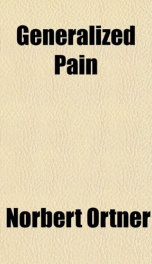generalized pain

Purchase of this book includes free trial access to www.million-books.com where you can read more than a million books for free. This is an OCR edition with typos. Excerpt from book: Pain in the Buttocks If a patient complains of pains in the coccy- geal region, we generally have before us a traumatic surgical disease (a birth or a fall). It may be a periostitis, a subluxation, or a luxation of the coccyx against the sacrum, or a fracture, or tuberculous caries or osteomalacia. If examination per rectum and the X-rays prove the absence of all these affections, and if we are satisfied that no rectal disorders (fissure, fistula, neoplasm) or genital or pelvic defects that might be mistaken for coccygodynia, are present, we are still confronted by disturbances which may be causative factors of pains in the nates. There is the possibility of neuralgia of the coccygeal plexus, frequently a sequel of masturbation, sometimes the expression of a sexual neurasthenia, or in rare cases the manifestation of gouty diathesis. I have seen two cases of coccygodynia in menit occurs in women with greater frequencywhich were indubitably accompanied by chronic gouty diathesis. Both diseases yielded promptly to therapeutic measures. Coccygodynia in the climacteric period may, perhaps, be explained in this manner. On the other hand, we come across cases in women in which this disease of the coccyx is only a partial manifestation of a generalized hysteria. ; Besides tenderness to pressure of an otherwise quite normal coccyx and localized cutaneous hyperesthesia, we are bound to discover other signs of hysteria, and as the causative element an acute psychic trauma with the elimination of which both coccygodynia and hysteria vanish. Of course, we find in non-complicated hysteria also pain and delicacy to touch, also cutaneous hy- peralgesia in the coccygeal region as well as in the sacrum, with deep pains in the Delvis radiating into the corresponding vertebral surroundi...
Users who have this book
Users who want this book
What readers are saying
What do you think? Write your own comment on this book!
write a commentif you like generalized pain try:
Other books by this author
Do you want to read a book that interests you? It’s EASY!
Create an account and send a request for reading to other users on the Webpage of the book!


